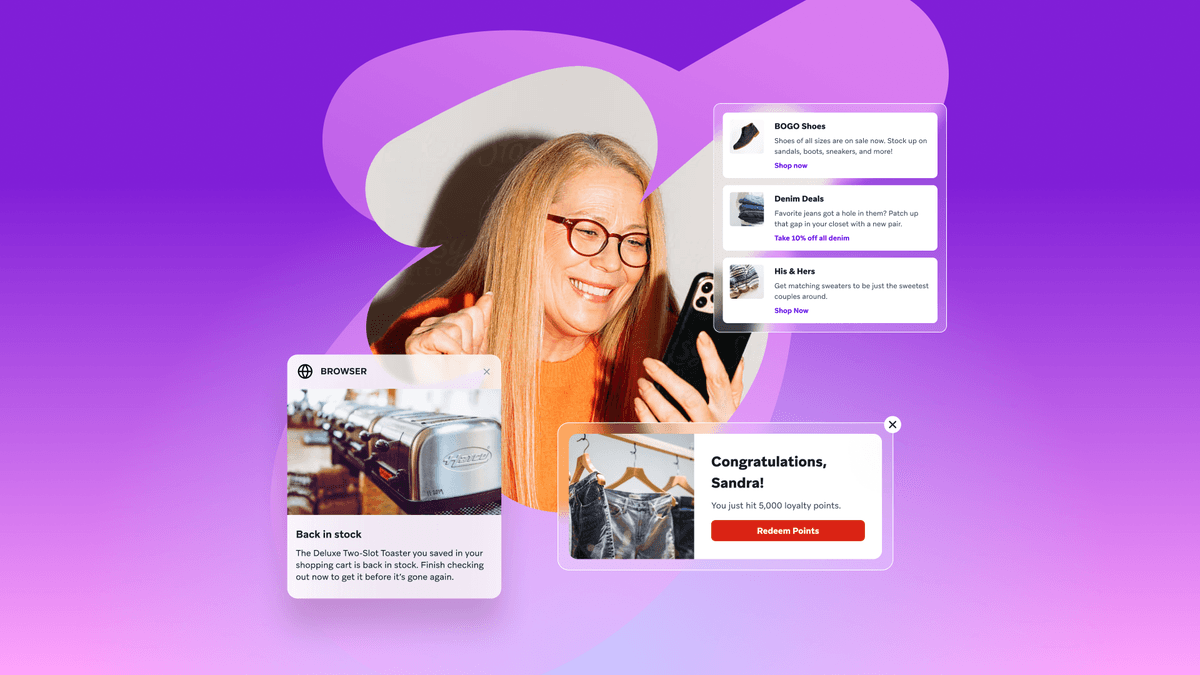Published on December 21, 2018/Last edited on December 21, 2018/7 min read


Hardly anyone spends all their time on just one kind of digital device. We mix it up, usually among phone, tablet, and computer, sometimes with a smattering of accessories and other entertainment devices folded in. The map of our individual digital footpath through our day doesn’t look like anyone else’s.
Here’s the trick: we have to remember this when we put our marketer hats back on. When you’re planning your next campaign and the ways that you plan to connect with your customers, think about all the different channels, platforms, and devices YOU use on a daily basis. Already thinking this way? Then hat’s off to you (see what I did there?). Realizing that your customers’ digital footprints are unique offers a great opportunity: there’s more and more ways to reach your customers. The challenge? There’s more and more ways to reach your customers...how do you do it in a way that’s strategic, individualized, and scalable all at once?
We mostly know how to organize our campaigns across multiple channels. Now let’s consider how to fold in multiple devices (and we’re going way beyond desktop email).
Because every person’s digital footprint is so unique, it’s tough to know at which stage, channel, or device they’re most likely to convert. Maybe some people (🙋) hate filling out purchase information on mobile. Maybe some people love getting Lyft updates on their smart speaker because their phone’s always on silent. Truthfully, it will be difficult to come up with the perfect cross-device strategy in a conference room. Instead, start testing! Use campaign visualization tools like Braze Canvas to test out different cross-channel and cross-device paths. This way, you can really narrow down the when and where conversions are most likely to occur for different customer segments. Once you find the winner, start testing it against new ideas.Ready to get inspired? Let’s explore a few hypothetical examples of how different people might access various digital media throughout their day.
Mason is an artist and a barista. He always carries his smartphone, which he uses throughout the day to check social media, post photos, check email and his dating apps, and stream music. He also loves reddit and other social conversation apps. He has a tablet at home which he mostly uses to edit images for his art. He also watches movies and reads books and articles on his tablet while he travels. He streams TV and movies through his Roku, and uses his Echo Dot to find recipes and play music while he’s around the house.
How to target Mason across a few devices
As we know, mobile data provides a valuable (and often overwhelming) array of information about our users. With his consent, we can track where Mason goes, what stores he visits, and for how long he’s there. We can discern what he buys, how much he spends, and, generally speaking, how he behaves. We can suss out patterns and build a profile, and then market to him with relevant offers and messaging based on what we’ve learned about him.
Too often, mobile marketing is quick-and-dirty—engage fast, then return customers to their day. What we should be striving for is building a relationship with customers through multiple touchpoints, adding value wherever we can. We can catch Mason when he returns home and, say, asks Alexa to crank the Bee Gees while he stuffs some portobellos and chills a nice dry prosecco for a bro-dinner.
At home in his kitchen, Mason may be a more a receptive audience. If we know he’s using Alexa to search for recipes, maybe we’ll want to place ads on popular recipe sites. If he’s using YouTube, maybe that’s where we should be. If he’s streaming Spotify, maybe there’s room for us there as well. In this way, we’re able to use mobile data to inform at-home marketing.
Susan is a semi-retired marketing consultant who relies most heavily on her ultra lightweight laptop. She uses a smartphone from the same brand to stay in touch with clients, and has a second phone for personal use. She’s just bought a smart TV, and has used a few apps like Netflix and YouTube, but hasn’t realized the full potential of that just yet. She travels quite a bit, and uses both her personal phone and laptop for entertainment and business while on the road.
How to target Susan across her devices
Susan has a fairly straightforward laptop/mobile usage pattern; in her case, there aren’t too many pieces of the puzzle. Still, she probably represents a whole category of users, so she’s important to consider. Her experience across channels and devices should be clean, consistent, and pleasing.
Susan is busy. Her messages, no matter the device, need to be timely and relevant. Not to mention, she’s very aware when she’s being marketed too, she is a marketer, afterall! So messages should be consistent across channels and optimized by device. If we are sending her to look at a pair of shoes within a website, we’d best be using a deep link to make sure that she’s send either straight to the item within the app, or on the website depending on where she is in that moment.
When Susan takes a break and relaxes with her Smart TV, we need to be sure that whatever marketing message comes through her smart TV is consistent with what she’s seeing on mobile and laptop. If smart TV users are segmented in some completely different way, she might be exposed to efforts that don’t correlate to what she’s used to on her primary devices, and that could be a turn-off.
Kaylee is a grad student who has a PC laptop for her schoolwork, an Apple Watch for fitness tracking, a smartphone she uses mostly for social media and Snapchat, and a fully integrated Bluetooth car system because her parents think it’s safer.
How to target Kaylee across her devices
We’ve already covered the integration of pc-to-mobile marketing. The next step is wearables, which require an even quicker engagement strategy than smartphones. If users engage in a hurry on smartphones and move on, as compared to the more languorous way people interact on PCs, watches get just the most fleeting glance. Let’s put those customer empathy hats on again. If you’re on a laptop, you’re probably open to some richer content. You may be open to more steps in a marketing flow, since you’re not on-the-go. Mobile may call for some more intentional relevance. If Kaylee is in class and her phone buzzes, she’ll be pretty annoyed if she misses some notes in class to get a useless notification (or one that requires more of her time to act on or benefit from), so leveraging send-time optimization to avoid bugging her at an inconvenient time is a must. Now, when we get to wearables, she’ll want even more bite-sized information. Her wearable is probably less about actually getting information, and more about knowing that there is information to get. Some good wearable-ready messages may be if her girlfriend texts her about dinner plans while she’s at the gym, or her brother’s birthday gift shipped in the mail.
Repetition is good. Repetition with variation is even better. You can’t really know which version of your message will strike home, and when or where or how. The idea of cross-channel marketing is that the different branches of your campaign reinforce each other. They create a cohesive picture without bludgeoning users with your message. The balance is understanding that the combined outreach on all the different platforms a person uses can have a powerful effect, so think in multiple channels, and think across multiple devices, but remember not to beat users over the head with whatever it is you’re trying to do.
The idea of cross-channel marketing is that the different branches of your campaign reinforce each other.
When it comes to cross-channel, -platform, and -device messaging, follow the Golden Rule. Think: Is this a message I would want to receive? Is this a message that’s relevant? Does this message make sense where I’m receiving it? Once you’re able to answer those questions, keep testing new messages, paths, and channels to see what’s resonating with your customers, and—while you should optimize content for whatever channel, device, or platform you’re using—make sure that your voice, message, and offer are staying consistent for a cohesive customer experience.
Sign up for regular updates from Braze.





